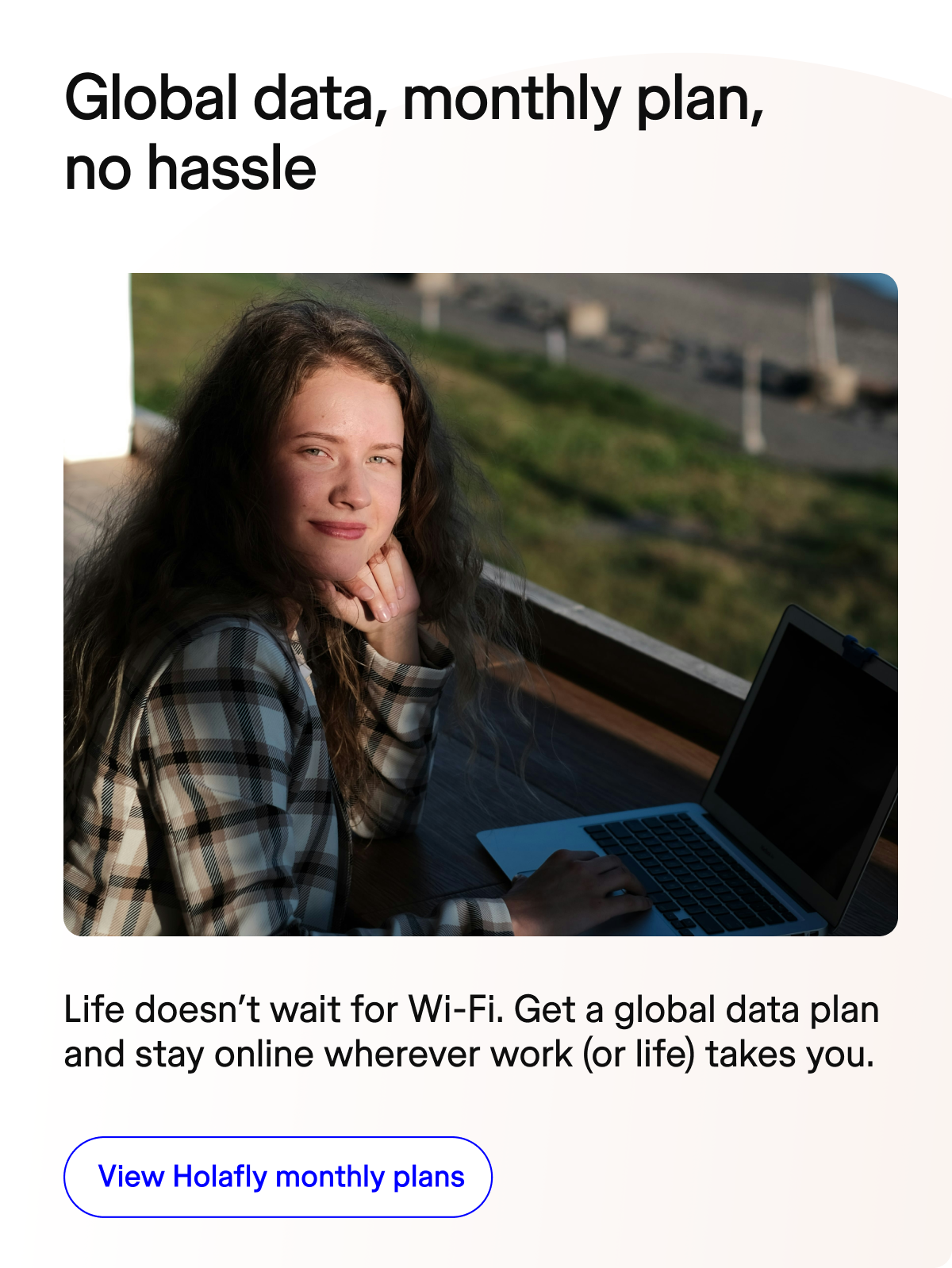Barcelona pulses with Mediterranean energy while powering one of Europe’s most dynamic tech ecosystems. This Catalonian capital doesn’t just offer Gothic quarters and Gaudí masterpieces—it delivers world-class digital infrastructure that makes remote work from tapas bars and beachfront cafes genuinely productive. Understanding how to navigate the internet in Barcelona becomes essential when your livelihood depends on reliable connectivity.
Spain’s telecommunications revolution has transformed Barcelona into a fiber-optic powerhouse, where average broadband speeds of 171.8 Mbps rival major European tech hubs. The city’s competitive provider landscape—dominated by Movistar, Vodafone, Orange, and innovative challengers like Digi—creates opportunities for savvy digital nomads to secure premium connectivity at surprisingly affordable rates.
The internet in Barcelona’s digital landscape: where speed meets lifestyle

Accessing reliable internet in Barcelona reflects Spain’s ambitious digital transformation goals, with fiber optic coverage reaching virtually every neighborhood from the tourist-heavy Ciutat Vella to the innovative 22@ tech district in Poblenou. Recent infrastructure investments have positioned Barcelona among Europe’s best-connected cities, with Digi leading broadband speeds at 244.7 Mbps and mobile networks delivering consistent 4G/5G coverage across the metropolitan area.
This connectivity revolution supports Barcelona’s emergence as a premier digital nomad destination, where reliable internet access enables productive work sessions, whether you’re stationed in a Gràcia coworking space or conducting video calls from a Barceloneta beach café. The city’s commitment to digital infrastructure creates an environment where remote professionals can seamlessly blend productivity with the renowned Catalonian quality of life.
💡 Did you know? Barcelona’s 22@ innovation district houses over 1,500 companies and maintains some of Europe’s most advanced fiber networks, with many buildings offering direct connections to major internet exchanges across the continent.
Provider powerhouses: choosing amid a competitive market
Selecting the best option for mobile internet in Barcelona means choosing between established telecom titans, each offering distinct advantages for different user profiles. Movistar dominates through its legacy infrastructure and comprehensive service coverage, consistently winning Opensignal awards for network reliability and customer experience. Their English-speaking customer service proves invaluable for international residents navigating complex service contracts.
Vodafone targets urban professionals with competitive fiber packages and aggressive promotional pricing, often bundling internet, mobile, and TV services at attractive rates. Their network particularly excels in Barcelona’s business districts and upscale residential areas. Orange leverages French telecommunications expertise to offer innovative service packages, while newcomer Digi disrupts traditional pricing with exceptional speed-to-cost ratios.
🌟 Pro tip: forget traditional SIM hunting entirely—Holafly’s cutting-edge eSIM technology delivers instant Barcelona connectivity without store visits, language barriers, or documentation delays, perfect for nomads needing immediate digital access.
Neighborhood network realities
Getting quality internet in Barcelona depends heavily on your chosen neighborhood, creating connectivity microclimates that affect remote work productivity. The Gothic Quarter’s historic charm comes with infrastructure challenges—medieval buildings sometimes limit fiber installation, though major streets maintain excellent coverage. Eixample’s grid layout facilitates comprehensive fiber deployment, delivering consistent high-speed connectivity throughout this central district.
Poblenou emerges as Barcelona’s digital nomad paradise, combining beachfront proximity with cutting-edge infrastructure designed for the 22@ tech hub. Here, multiple fiber providers compete intensely, driving both speeds and service quality to exceptional levels. Gràcia offers a bohemian atmosphere with surprisingly robust connectivity, while neighborhoods like Sarrià-Sant Gervasi provide residential tranquility without sacrificing digital infrastructure quality.
Coastal areas, including Barceloneta, maintain strong mobile coverage but may have limited fixed broadband options in older buildings. Understanding these neighborhood nuances helps nomads select accommodation that supports their specific connectivity requirements while enjoying Barcelona’s diverse urban experiences.
Bureaucratic navigation: setting up the internet in Barcelona as a foreigner
Establishing a fixed internet connection in Barcelona requires understanding Spain’s bureaucratic landscape, particularly the NIE (Número de Identificación de Extranjero) system that affects service eligibility. While Movistar accepts passport identification for basic internet contracts, most providers prefer NIE documentation for comprehensive service packages. This reality makes mobile solutions attractive for short-term visitors who need immediate connectivity.
Fixed internet installation typically involves coordination between building administrators, service providers, and sometimes neighborhood infrastructure committees—particularly in older Ciutat Vella buildings with protected architectural status. Installation timelines range from same-day service in modern Poblenou developments to several weeks in historic properties requiring special permissions.
💡 Did you know? Barcelona’s building regulations sometimes require unanimous neighbor approval for new telecommunications installations in historic buildings, making mobile internet solutions essential backup options for residents in Gothic Quarter apartments.
Economic optimization: maximizing the internet in Barcelona while managing costs

Understanding pricing structures for the internet in Barcelona helps nomads optimize their connectivity investments within Spain’s competitive telecommunications market. Fiber internet typically costs €30-50 monthly for residential speeds up to 600 Mbps, while premium packages approaching 1 Gbps remain competitively priced around €60-80. Mobile plans with substantial data allowances start from €15-25 monthly, making combined connectivity surprisingly affordable.
Promotional pricing during back-to-school periods (September) and New Year campaigns can reduce costs by 30-50% for new customers willing to commit to annual contracts. Group negotiations with fellow nomads or coliving residents sometimes unlock business rates for multiple connections, while student discounts apply to various demographics with appropriate documentation.
Currency considerations matter less for EU residents, but non-EU nomads should consider exchange rate fluctuations when planning long-term service contracts. Some providers accept international payment methods, while others require Spanish bank accounts for automatic billing arrangements.
Workspace ecosystems: professional coworking scene
Barcelona’s coworking scene spans from corporate-focused spaces in Eixample’s business district to creative hubs in Poblenou’s converted industrial buildings. Established providers like MOB, Aticco, and La Vaca offer professional-grade internet with redundant connections, ensuring productivity during peak usage periods. These spaces often maintain relationships with multiple ISPs, providing backup connectivity when primary systems experience maintenance or disruptions.
Neighborhood-specific coworking options include Gràcia’s boutique spaces emphasizing community interaction and Sarrià’s quieter environments suited for concentrated work. Many locations offer day passes for nomads testing different areas before committing to longer-term arrangements. Premium spaces provide additional services like dedicated video conference facilities, printing services, and networking events connecting local and international remote workers.
Public workspace alternatives include Barcelona’s extensive library system, many featuring dedicated digital work areas with reliable Wi-Fi and professional atmospheres. Beach clubs and upscale cafes increasingly cater to digital nomads with robust internet infrastructure and laptop-friendly environments.
Mobile mastery: optimizing wireless internet in Barcelona

Mobile internet in Barcelona offers exceptional flexibility for nomads requiring connectivity across diverse locations and usage patterns. Major providers deliver consistent 4G coverage throughout the metropolitan area, with 5G deployment accelerating in business districts and tourist areas. Mobile speeds regularly exceed 100 Mbps in optimal conditions, supporting video conferencing and cloud-based applications without degradation.
Prepaid options provide cost control and flexibility, while contract plans offer better value for extended stays. Tourist-specific packages from major providers include substantial data allowances and EU roaming capabilities, perfect for nomads exploring broader European regions. eSIM technology eliminates physical SIM management while enabling quick provider switches based on coverage or pricing preferences.
International roaming partnerships make Barcelona an ideal base for European exploration, with seamless connectivity across EU member states. Understanding provider strengths—Movistar for rural coverage, Orange for urban speeds, Vodafone for international partnerships—enables informed decision-making based on specific travel and work patterns.
Troubleshooting common internet issues
Reliable internet in Barcelona occasionally faces challenges that remote workers should anticipate and prepare for. Summer tourism surges can strain networks in popular areas like La Rambla and Sagrada Família, where cellular towers experience peak usage. Understanding these patterns helps nomads schedule bandwidth-intensive work during off-peak hours or at alternative locations.
Weather-related disruptions remain rare but can affect service quality during severe Mediterranean storms. Coastal areas may experience brief interruptions during extreme weather events, making backup connectivity essential for business-critical applications. Most providers offer mobile apps for real-time service monitoring and quick issue reporting.
Language barriers sometimes complicate technical support interactions, though major providers maintain English-speaking customer service departments. Having basic Spanish telecommunications vocabulary proves helpful for local technician interactions and neighborhood-level troubleshooting scenarios.
💡 Did you know? Barcelona’s smart city initiatives include free municipal Wi-Fi in major squares and parks, providing backup connectivity options during primary service maintenance or emergencies, though speeds may be limited during peak usage periods.
Strategic connectivity planning for the long-term
Successfully optimizing internet access in Barcelona requires balancing immediate needs with longer-term strategic considerations. Mobile solutions provide instant connectivity for arrival and neighborhood exploration, while fixed installations support sustained productivity for extended stays. Understanding provider specializations enables informed selection—Movistar for comprehensive coverage, Vodafone for urban performance, Digi for value optimization.
Professional-grade connectivity benefits from redundancy planning through multiple providers, coworking memberships, and mobile backup systems. Barcelona’s competitive market rewards research and negotiation, with substantial savings available for informed consumers willing to explore alternatives beyond default tourist-focused packages.
For digital nomads exploring Mediterranean Europe’s opportunities, Barcelona offers an ideal combination of lifestyle quality and technical infrastructure. Consider discovering our detailed analysis of Barcelona’s premier coworking spaces to complement your connectivity strategy with productive workspace options throughout the city.
Ready to establish your connected Mediterranean base in Barcelona’s vibrant digital ecosystem? Nomada streamlines every aspect of your remote work journey, from connectivity optimization to cultural integration 👉
Frequently asked questions
According to recent SpeedGEO data, Digi leads with average download speeds of 244.7 Mbps for fixed broadband, while Movistar dominates mobile internet at 158.5 Mbps. However, actual speeds vary significantly by location and network congestion, with fiber installations generally outperforming other technologies.
Mobile internet activates immediately through SIM cards available at El Prat Airport or city retailers, requiring only passport identification. Fixed broadband installation takes 1-2 weeks in most areas, though modern Poblenou buildings may offer same-day activation. Historic neighborhoods may require extended installation periods.
NIE (foreign identification number) requirements vary by provider and service type. Movistar accepts passport identification for basic internet contracts, while Vodafone typically requires NIE documentation. Mobile services generally need only passport verification, making them ideal for short-term visitors.
Residential fiber internet ranges from €30-50 monthly for speeds up to 600 Mbps, with premium gigabit packages costing €60-80. Mobile plans with substantial data start around €15-25 monthly. Combined packages often provide better value than separate services.
Major residential and business areas maintain stable service year-round, though tourist zones may experience slower mobile speeds during summer peaks. Most providers manage capacity effectively, but backup connectivity proves valuable for business-critical applications during major events or festivals.

